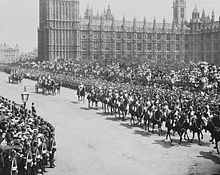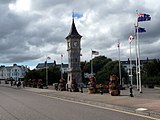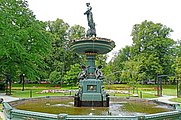Diamond Jubilee of Queen Victoria
| Diamond Jubilee of Queen Victoria | |
|---|---|
 Queen Victoria's Diamond Jubilee procession passing over London Bridge, 1897 by Helen Thornycroft | |
| Genre | Jubilee of British monarch |
| Date(s) | 20 June 1897 |
| Country |
|
| Previous event | Golden Jubilee of Queen Victoria |
| Next event | Silver Jubilee of George V |
The Diamond Jubilee of Queen Victoria was officially celebrated on 22 June 1897 to mark the occasion of the sixtieth anniversary of Queen Victoria's accession on 20 June 1837. It was the first ever Diamond Jubilee celebration of any British monarch in history.
Background[]
Queen Victoria surpassed her grandfather King George III as the longest-reigning British monarch on 23 September 1896, an event that she marked privately at Balmoral Castle. She wrote in her journal, "People wished to make all sorts of demonstrations, which I asked them not to do until I had completed the sixty years next June." The Diamond Jubilee was therefore an opportunity celebrate Victoria’s status as longest-reigning monarch, in addition to marking 60 years on the throne.[1] On 20 June 1897, the sixtieth anniversary of her accession, Victoria wrote in her journal:[2]
This eventful day, 1897 has opened, and I pray God to help and protect me as He has hitherto done these sixty long eventful years! I feel sad at the new losses I have sustained, especially the last one of our beloved Liko! God will surely help me on! How well I remember this day sixty years ago when I was called from my bed by dear Mama to receive the news of my accession!
The sixtieth anniversary of her accession was celebrated on 20 June 1897 with a thanksgiving service at St George's Chapel, Windsor Castle.[1]
Celebrations[]

The occasion was marked publicly two days later by the Festival of the British Empire proposed by Joseph Chamberlain, who promoted the idea of a global celebration fit for a monarch ruling over 450 million people.[3] The day was declared a bank holiday in Britain, Ireland and India. The British Army and Royal Navy as well as troops from Canada, India, Africa and the South Pacific took part in the procession in London.[3] The Queen telegraphed a message to all nations in the British Empire: "From my heart I thank my beloved people. May God bless them."[2]
At 11:15 am, the Queen, along with Princess Helena and the Princess of Wales, took part in the parade in an open carriage from Buckingham Palace to St Paul's Cathedral, where thanksgiving service took place.[4] Seventeen other carriages carrying members of the royal family followed her.[4] Eleven colonial prime ministers were in attendance:[5][6]
 The Prime Minister of Canada and Lady Laurier
The Prime Minister of Canada and Lady Laurier The Premier of New South Wales
The Premier of New South Wales The Premier of Victoria and Lady Turner
The Premier of Victoria and Lady Turner The Premier of New Zealand and Mrs Seddon
The Premier of New Zealand and Mrs Seddon The Premier of Queensland and Lady Nelson
The Premier of Queensland and Lady Nelson The Premier of South Australia and Mrs Kingston
The Premier of South Australia and Mrs Kingston The Prime Minister of Cape Colony and Lady Sprigg
The Prime Minister of Cape Colony and Lady Sprigg The Premier of Tasmania and Lady Braddon
The Premier of Tasmania and Lady Braddon The Premier of Newfoundland and Lady Whiteway
The Premier of Newfoundland and Lady Whiteway The Premier of Western Australia and Lady Forrest
The Premier of Western Australia and Lady Forrest The Prime Minister of Natal and Mrs Escombe
The Prime Minister of Natal and Mrs Escombe
Suffering from severe arthritis and unable to climb the steps, the Queen remained in her coach, so the short service of thanksgiving was held outside the building.[3][5] She was joined by the clergy and dignitaries.[4] Victoria returned to Buckingham Palace after touring a large area of London. Later, when reflecting on the occasion Victoria said:
No-one ever, I believe, has met with such an ovation as was given to me, passing through those six miles of streets... The crowds were quite indescribable and their enthusiasm truly marvellous and deeply touching. The cheering was quite deafening and every face seemed to be filled with joy.[3]
Thousands of residents in London and Manchester took part in street feasts, where Thomas Lipton distributed free ale and tobacco.[3] A chain of beacons were lit across the United Kingdom and Nottingham, Bradford and Hull were granted their city charter as part of the celebrations.[3] The following day the Queen visited Constitution Hill where 10,000 schoolchildren had gathered, and attended a reception in Slough.[3]
The celebrations lasted a fortnight and a garden party at Buckingham Palace and a state banquet were held to mark the occasion.[4] Memorial fountains and towers were erected to mark the occasion, including the Jubilee Tower and the Cunningham Clock Tower. Alfred Austin and Rudyard Kipling also wrote special poems in honour of the Queen.[4]
Royal guests at the Jubilee celebration[]
British royal family[]
- The Queen of the United Kingdom
 The Empress Frederick, the Queen's daughter
The Empress Frederick, the Queen's daughter
 The Hereditary Princess of Saxe-Meiningen, the Queen's granddaughter (representing the Duke of Saxe-Meiningen)
The Hereditary Princess of Saxe-Meiningen, the Queen's granddaughter (representing the Duke of Saxe-Meiningen)
 Prince and Princess Henry of Prussia, the Queen's grandson and granddaughter (representing the German Emperor)
Prince and Princess Henry of Prussia, the Queen's grandson and granddaughter (representing the German Emperor) Princess and Prince Adolf of Schaumburg-Lippe, the Queen's granddaughter and grandson-in-law (representing the Prince of Schaumburg-Lippe)
Princess and Prince Adolf of Schaumburg-Lippe, the Queen's granddaughter and grandson-in-law (representing the Prince of Schaumburg-Lippe)- Princess and Prince Frederick Charles of Hesse, the Queen's granddaughter and grandson-in-law
- The Prince and Princess of Wales, the Queen's son and daughter-in-law
- The Duke and Duchess of York, the Queen's grandson and granddaughter-in-law
- Prince Edward of York, the Queen's great-grandson
- Prince Albert of York, the Queen's great-grandson
- Princess Mary of York, the Queen's great-granddaughter
- The Duchess and Duke of Fife, the Queen's granddaughter and grandson-in-law
- Princess Victoria of Wales, the Queen's granddaughter
 Princess and Prince Charles of Denmark, the Queen's granddaughter and grandson-in-law
Princess and Prince Charles of Denmark, the Queen's granddaughter and grandson-in-law
- The Duke and Duchess of York, the Queen's grandson and granddaughter-in-law
 The Duke and Duchess of Saxe-Coburg and Gotha, the Queen's son and daughter-in-law
The Duke and Duchess of Saxe-Coburg and Gotha, the Queen's son and daughter-in-law
 The Hereditary Prince of Saxe-Coburg and Gotha, the Queen's grandson
The Hereditary Prince of Saxe-Coburg and Gotha, the Queen's grandson The Grand Duchess and Grand Duke of Hesse and by Rhine, the Queen's granddaughter and grandson
The Grand Duchess and Grand Duke of Hesse and by Rhine, the Queen's granddaughter and grandson- The Hereditary Princess and Hereditary Prince of Hohenlohe-Langenburg, the Queen's granddaughter and grandson-in-law
 Princess Beatrice of Saxe-Coburg and Gotha, the Queen's granddaughter
Princess Beatrice of Saxe-Coburg and Gotha, the Queen's granddaughter
- Princess and Prince Christian of Schleswig-Holstein, the Queen's daughter and son-in-law
- Prince Christian Victor of Schleswig-Holstein, the Queen's grandson
- Prince Albert of Schleswig-Holstein, the Queen's grandson
- Princess Helena Victoria of Schleswig-Holstein, the Queen's granddaughter
 Princess and Prince Aribert of Anhalt, the Queen's granddaughter and grandson-in-law (representing the Duke of Anhalt)
Princess and Prince Aribert of Anhalt, the Queen's granddaughter and grandson-in-law (representing the Duke of Anhalt)
- Princess Louise, Marchioness of Lorne and the Marquess of Lorne, the Queen's daughter and son-in-law
- The Duke and Duchess of Connaught and Strathearn, the Queen's son and daughter-in-law
- Princess Margaret of Connaught, the Queen's granddaughter
- Prince Arthur of Connaught, the Queen's grandson
- Princess Patricia of Connaught, the Queen's granddaughter
- The Duchess of Albany, the Queen's daughter-in-law
- Princess Alice of Albany, the Queen's granddaughter
- The Duke of Albany, the Queen's grandson
- Princess Henry of Battenberg, the Queen's daughter
- Prince Alexander of Battenberg, the Queen's grandson
- Princess Victoria Eugenie of Battenberg, the Queen's granddaughter
- Prince Leopold of Battenberg, the Queen's grandson
- Prince Maurice of Battenberg, the Queen's grandson
- Princess and Prince Louis of Battenberg, the Queen's granddaughter and grandson-in-law
- Princess Alice of Battenberg, the Queen's great-granddaughter
- Princess Louise of Battenberg, the Queen's great-granddaughter
- Prince George of Battenberg, the Queen's great-grandson
 Grand Duchess Elizabeth Feodorovna and Grand Duke Sergei Alexandrovich of Russia, the Queen's granddaughter and grandson-in-law (representing the Emperor of Russia)
Grand Duchess Elizabeth Feodorovna and Grand Duke Sergei Alexandrovich of Russia, the Queen's granddaughter and grandson-in-law (representing the Emperor of Russia)
Other descendants of The Queen's paternal grandfather, King George III and their families:
- The Duke of Cambridge, the Queen's first cousin
 The Grand Duchess and Grand Duke of Mecklenburg-Strelitz, the Queen's first cousin and her husband
The Grand Duchess and Grand Duke of Mecklenburg-Strelitz, the Queen's first cousin and her husband- The Duchess and Duke of Teck, the Queen's first cousin and her husband
- Prince and Princess Adolphus of Teck, the Queen's first cousin once removed and his wife
- Prince Francis of Teck, the Queen's first cousin once removed
- Prince Alexander of Teck, the Queen's first cousin once removed
- Princess Frederica of Hanover and Baron Alphons von Pawel-Rammingen, the Queen's first cousin once removed and her husband
- The Hon. Aubrey FitzClarence, great-grandson of King William IV
Foreign royals[]
- The Prince and Princess of Leiningen, the Queen's half-nephew and half-niece-in-law
- Princess Victor of Hohenlohe-Langenburg, the Queen's half-niece-in-law
- Countess Feodora Gleichen, the Queen's half-great-niece
- Count Edward Gleichen, the Queen's half-great-nephew
- Countess Victoria Gleichen, the Queen's half-great-niece
- Countess Helena Gleichen, the Queen's half-great-niece
 The Prince and Princess of Naples (representing the King of Italy)
The Prince and Princess of Naples (representing the King of Italy) Archduke Franz Ferdinand of Austria (representing the Emperor of Austria)
Archduke Franz Ferdinand of Austria (representing the Emperor of Austria) The Crown Prince of Siam (representing the King of Siam)
The Crown Prince of Siam (representing the King of Siam) Prince Mahit of Siam
Prince Mahit of Siam Prince Albert of Prussia, regent of the Duchy of Brunswick
Prince Albert of Prussia, regent of the Duchy of Brunswick Prince Valdemar of Denmark (representing the King of Denmark)
Prince Valdemar of Denmark (representing the King of Denmark) Prince Arisugawa Takehito (representing the Emperor of Japan)
Prince Arisugawa Takehito (representing the Emperor of Japan) The Duke of Närke (representing the King of Sweden and Norway)
The Duke of Närke (representing the King of Sweden and Norway) Grand Duke Kirill Vladimirovich of Russia
Grand Duke Kirill Vladimirovich of Russia Prince Rupprecht of Bavaria (representing the Prince Regent of Bavaria)
Prince Rupprecht of Bavaria (representing the Prince Regent of Bavaria) Prince Frederick, Duke of Saxony (representing the King of Saxony)
Prince Frederick, Duke of Saxony (representing the King of Saxony) The Duke of Porto (representing the King of Portugal)
The Duke of Porto (representing the King of Portugal) Duke Albrecht of Württemberg (representing the King of Württemberg)
Duke Albrecht of Württemberg (representing the King of Württemberg) The Hereditary Grand Duke of Luxembourg (representing the Grand Duke of Luxembourg)
The Hereditary Grand Duke of Luxembourg (representing the Grand Duke of Luxembourg) Prince Amir Khan of Persia (representing the Shah of Persia)
Prince Amir Khan of Persia (representing the Shah of Persia) The Hereditary Prince of Montenegro (representing the Prince of Montenegro)
The Hereditary Prince of Montenegro (representing the Prince of Montenegro) The Prince and Princess of Bulgaria
The Prince and Princess of Bulgaria Prince Philipp of Saxe-Coburg and Gotha
Prince Philipp of Saxe-Coburg and Gotha Prince August Leopold of Saxe-Coburg and Gotha
Prince August Leopold of Saxe-Coburg and Gotha Prince and Princess Edward of Saxe-Weimar
Prince and Princess Edward of Saxe-Weimar Prince Hermann of Saxe-Weimar-Eisenach (representing the Grand Duke of Saxe-Weimar-Eisenach)
Prince Hermann of Saxe-Weimar-Eisenach (representing the Grand Duke of Saxe-Weimar-Eisenach) Prince Mohammed Ali Tewfik (representing the Khedive of Egypt and Sudan)
Prince Mohammed Ali Tewfik (representing the Khedive of Egypt and Sudan)- Prince Charles de Ligne (representing the King of Belgium)
Gallery[]

Canada 5-cent Diamond Jubilee stamp, 1897

Queen Victoria's Diamond Jubilee Service, 22 June 1897 by Andrew Carrick Gow

Clock Tower in Exmouth erected in 1897, to commemorate the Diamond Jubilee of Queen Victoria

'In Honour of our Queen': Queen Victoria's Diamond Jubilee Review at Spithead, 26 June 1897

Victoria in her official Diamond Jubilee photograph by W. & D. Downey

Victoria Avenue Jubilee Crown erected in Jersey for Diamond Jubilee of Queen Victoria, 1897

Front cover of a programme for a musical event held at Exhibition Park on June 22, 1897, Toronto, Ontario, Canada in honour of Queen Victoria's Diamond Jubilee

The Victoria Jubilee Fountain at Halifax, Canada, built in 1897 to mark the Diamond Jubilee of Queen Victoria

The Clock Tower at Shanklin Esplanade, Isle of Wight, erected to commemorate the Diamond Jubilee of Queen Victoria in 1897
See also[]
References[]
- ^ a b "Queen Victoria's Diamond Jubilee – 1897". The Canadian Encyclopedia. 17 June 2015. Retrieved 28 June 2021.
- ^ a b McKernan, Luke (2012), "QUEEN VICTORIA'S DIAMOND JUBILEE" (PDF), lukemckernan.com
- ^ a b c d e f g Sully, Andy (22 May 2012). "Queen Victoria and Britain's first Diamond Jubilee". BBC. Retrieved 28 June 2021.
- ^ a b c d e "1897 - Victoria, Diamond". St Paul's Cathedral. Retrieved 28 June 2021.
- ^ a b "A history of Jubilees". Royal.uk. Retrieved 29 June 2021.
- ^ "THE QUEEN'S RECORD REIGN., NEW ZEALAND MAIL, ISSUE 1322, 1 JULY 1897, PAGE 31". Papers Past. 1 July 1897. Retrieved 29 June 2021.
- ^ https://www.thegazette.co.uk/London/issue/26947/data.pdf
- ^ "Illustrated Programme of the Royal Jubilee Procession" (PDF). London: 190 Strand. 1897. Retrieved 22 September 2021.
- 1897 in Canada
- 1897 in the United Kingdom
- British monarchy
- Monarchy in Canada
- Queen Victoria
- British Royal jubilees
- Events involving British royalty
- June 1897 events








